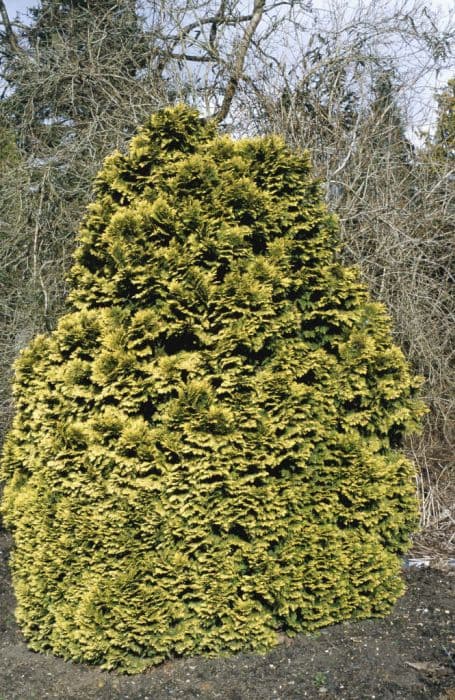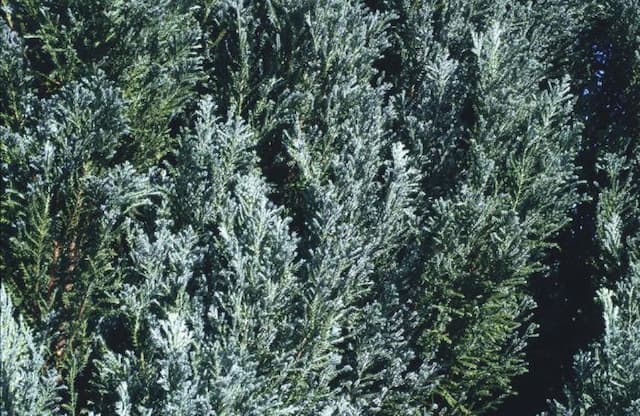Leyland cypress 'Robinson's Gold' × Cuprocyparis leylandii 'Robinson's Gold'

ABOUT
A vigorous evergreen conifer making a large tree of narrowly conical habit, to 15m or more, with flattened sprays of bright golden-yellow foliage, becoming green-tinged in late summer
About this plant
 Names
NamesFamily
Cupressaceae
Synonyms
Leyland Cypress, Leylandii, Robinson's Gold Cypress
Common names
× Cupressocyparis leylandii 'Robinson's Gold', Callitropsis × leylandii 'Robinson's Gold', Hesperotropsis leylandii 'Robinson's Gold', Cupressus × leylandii 'Robinson's Gold'.
 Characteristics
CharacteristicsLife cycle
Perennials
Foliage type
Evergreen
Color of leaves
Golden
Height
20 feet [6 meters]
Spread
8 feet [2.4 meters]
Plant type
Tree
Hardiness zones
6
Native area
Hybrid
Benefits
 General Benefits
General Benefits- Fast Growth: Leyland Cypress 'Robinson's Gold' is known for its rapid growth rate, making it ideal for quickly creating privacy screens or hedges.
- Attractive Foliage: The plant's golden-yellow foliage provides vibrant color and visual interest to gardens and landscapes.
- Low Maintenance: Once established, it requires relatively low maintenance, reducing the need for constant gardening efforts.
- Drought Tolerance: It has a good tolerance to dry conditions once established, making it suitable for areas with water restrictions.
- Windbreak: Its dense growth habit makes it an excellent windbreak, protecting gardens and properties from strong winds.
- Noise Reduction: The thick foliage can help to reduce noise pollution when planted in groups or as barriers along roads.
- Adaptability: Leyland Cypress 'Robinson's Gold' adapts well to a variety of soil types, though it prefers well-draining soils.
- Privacy: Dense foliage provides excellent privacy and can be used to shield unsightly views.
- Erosion Control: Their root systems can help stabilize soil and prevent erosion on slopes or in problem areas.
- Year-Round Interest: As an evergreen, it keeps its foliage year-round, offering continuous interest and color in the landscape.
 Medical Properties
Medical PropertiesThis plant is not used for medical purposes.
 Air-purifying Qualities
Air-purifying QualitiesThis plant is not specifically known for air purifying qualities.
 Other Uses
Other Uses- Leyland cypress 'Robinson's Gold' can be used in model-making or miniature landscapes due to its fine texture and dense foliage, adding a realistic touch to scaled-down scenes.
- Create natural art by using the branches and foliage for green sculptures or topiaries, allowing the bright foliage to add a splash of color.
- Use its flexible wood for crafting small homemade projects like picture frames or decorative wooden boxes which require light but sturdy material.
- Utilize its tall and dense growth habit as living walls or privacy screens in public gardens or outdoor event spaces.
- The plant can act as a windbreak in coastal areas, helping to reduce soil erosion from strong sea breezes.
- Clippings from leyland cypress 'Robinson's Gold' can be used as a fresh, natural mulch for garden beds, suppressing weeds and retaining soil moisture.
- The plant's quick growth rate makes it suitable for use in reclaiming land, such as former industrial sites or mine spoil heaps, contributing to landscape restoration efforts.
- Due to their rapid and dense growth, they can be used for noise reduction along highways or in urban settings where traffic noise is an issue.
- In large aquarium setups or reptile terrariums, branches can be used to create naturalistic habitats that provide cover and climbing opportunities for the inhabitants.
- The rich golden hue of the 'Robinson's Gold' foliage can provide a seasonal backdrop for photography, especially in autumn-themed photo shoots.
Interesting Facts
 Feng Shui
Feng ShuiThe Leyland Cypress is not used in Feng Shui practice.
 Zodiac Sign Compitability
Zodiac Sign CompitabilityThe Leyland Cypress is not used in astrology practice.
 Plant Symbolism
Plant Symbolism- Growth: Leyland Cypress is a rapidly growing tree, often symbolizing fast development and the ability to reach for high aspirations quickly.
- Privacy: Due to its common use as a privacy hedge, the Leyland Cypress can represent the need for personal space and boundaries.
- Endurance: This tree's hardiness and adaptability can be seen as a symbol of endurance and the ability to thrive in various conditions.
- Longevity: With its potential to live for several decades, the Leyland Cypress can symbolize long life and immortality.
- Protection: Its thick foliage often provides shelter to birds and small animals, thereby making it a symbol of protection and sanctuary.
 Water
WaterLeyland Cypress 'Robinson's Gold' should be watered deeply when the top 2 to 3 inches of soil is dry to touch, which typically means watering once every 7 to 10 days during the growing season. Depending on the soil and climate conditions, this may translate to about 1 to 2 gallons of water for young plants and up to 10 gallons for established trees every watering session. During the winter, water less frequently, but do not allow the soil to become completely dry. Adjust watering based on rainfall, temperature, and seasonal changes. Over-watering or poor drainage can lead to root rot, so ensure the soil is well-draining.
 Light
LightLeyland Cypress 'Robinson's Gold' thrives best in full sunlight, meaning at least 6 hours of direct, unfiltered sunlight per day. It can tolerate some partial shade, but its growth may be less dense. Plant it in a spot where it will receive ample light from the morning through the afternoon for optimal growth and health.
 Temperature
TemperatureLeyland Cypress 'Robinson's Gold' tolerates a wide range of temperatures and is hardy in USDA zones 6 through 10. It can generally withstand temperatures as low as -10°F and as high as 100°F, but the ideal temperature range is between 40°F and 80°F for optimal growth. Extended periods outside of this range may cause stress to the plant.
 Pruning
PruningLeyland Cypress 'Robinson's Gold' should be pruned to shape and maintain its size, remove any damaged or diseased branches, and promote denser foliage. The best time to prune is in the late winter or early spring before new growth starts. Prune no more than one-third of the plant's total height or width in a single season, and always use clean, sharp tools to make clean cuts.
 Cleaning
CleaningAs needed
 Soil
SoilLeyland Cypress 'Robinson's Gold' prefers a soil mix with good drainage, moderate fertility, and a pH range of 6.0 to 8.0. A mixture of garden soil, compost, and sharp sand or perlite would support healthy growth. Regular mulching will help maintain soil moisture and structure.
 Repotting
RepottingLeyland Cypress 'Robinson's Gold' is a large, fast-growing tree and is not typically repotted. Planting in the ground is preferable, and it should be given ample space to accommodate its size.
 Humidity & Misting
Humidity & MistingLeyland Cypress 'Robinson's Gold' is tolerant of a wide range of humidity levels but does best in an environment that resembles its natural outdoor habitat.
 Suitable locations
Suitable locationsIndoor
Not ideal inside; needs sun, space, well-drained soil.
Outdoor
Plant in a sunny spot, with well-drained soil, space to grow.
Hardiness zone
6-10 USDA
 Life cycle
Life cycleLeyland cypress 'Robinson's Gold' starts its life as a seed, often a hybrid product of two parent species, Cupressus macrocarpa and Chamaecyparis nootkatensis. Upon germination, the seedling develops a rooting system and a shoot that quickly turns into a juvenile sapling with characteristic golden foliage. As it matures, the sapling grows into a large, fast-growing evergreen tree, which may reach substantial heights within a few years. Throughout its life, it undergoes periods of active growth in the spring and summer, followed by dormancy in the fall and winter. Reproductive maturity is reached after several years, enabling the tree to produce cones containing seeds, thus completing the sexual part of its lifecycle. The Leyland cypress 'Robinson's Gold' has a lifespan of several decades, and in the absence of disease or environmental stress, it remains a robust ornamental tree throughout its life.
 Propogation
PropogationPropogation time
Early spring
The Leyland Cypress 'Robinson's Gold', a widely cultivated conifer, is most commonly propagated through semi-hardwood cuttings. This popular method involves selecting healthy, vigorous shoots from the current year's growth during late summer to early autumn. The cuttings, usually 6 to 8 inches (15 to 20 centimeters) long, are taken from the middle portion of the branches, avoiding the soft tips and the hardened base. After cutting, the lower needles are removed, and the base of the cutting is dipped in rooting hormone to enhance root development. The treated cuttings are then inserted into a well-draining, sterile rooting medium and kept under high humidity with bottom heat, around 70 to 75 degrees Fahrenheit (21 to 24 degrees Celsius), to encourage rooting. It typically takes several weeks to a few months for the cuttings to form a robust root system, after which they can be transplanted into individual pots or directly into the landscape.









